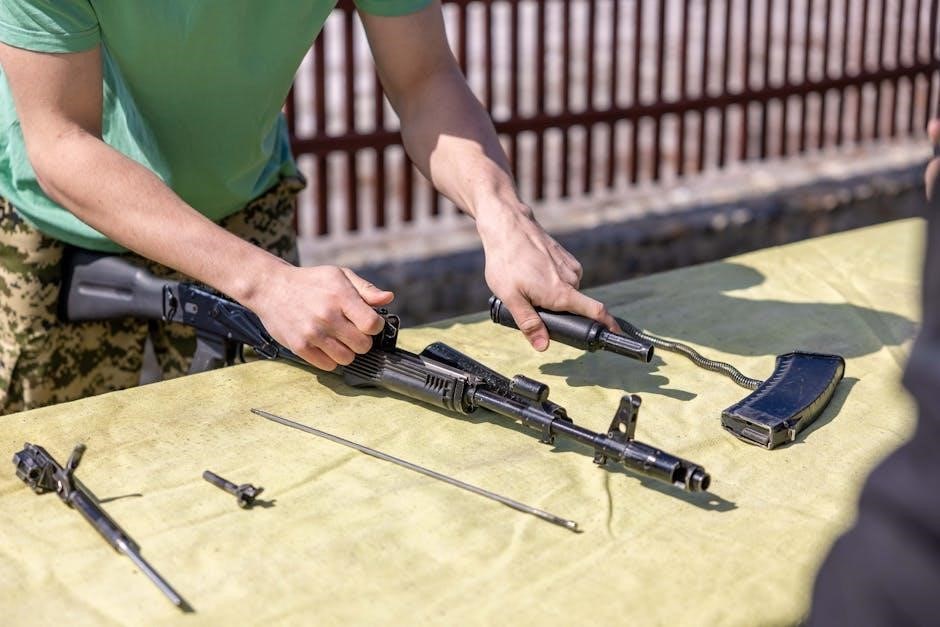Bounty Hunter metal detector manuals are essential guides․ These manuals provide comprehensive instructions for operating and maintaining your device․ They cover everything from basic setup to advanced features like discrimination settings․ Understanding the manual ensures optimal performance and successful treasure hunting․
Understanding Your Bounty Hunter Metal Detector
Familiarizing yourself with your Bounty Hunter metal detector is crucial․ Learn about its components, functions, and capabilities before use․ Knowing your detector’s features, such as target identification, enhances your ability to find valuable items and distinguish them from unwanted metals․
Identifying the Model
Identifying your Bounty Hunter metal detector model is the first step in properly using its manual․ The model name is typically found on the detector’s housing or control panel․ Locating the correct model ensures you’re referencing the appropriate instructions for your specific device․
Different models have varying features and settings, so using the wrong manual can lead to confusion or incorrect operation․ Check for labels or engravings on the detector’s body, near the display screen, or on the battery compartment cover․ The model number is crucial for accessing accurate information․
Once you’ve located the model name, you can easily find the corresponding manual online or in the documentation provided with your detector․ Having the right manual will help you understand the specific functions and capabilities of your Bounty Hunter metal detector, maximizing your treasure hunting experience․
Confirming the model enables you to troubleshoot effectively and take advantage of all available features․
Basic Operations and Settings
Understanding the basic operations and settings is crucial for effective use․ This section covers powering on, battery information, and sensitivity adjustment․ Mastering these fundamentals will improve your metal detecting success and prevent common errors․
Powering On and Battery Information
To begin your treasure hunt, ensure your Bounty Hunter metal detector is properly powered․ Locate the power button, typically a switch or a button on the control panel․ Press or slide it to the “ON” position․ A beep or a display light indicates successful power-up․
Battery information is critical for uninterrupted searching․ Most Bounty Hunter detectors require a 9-volt alkaline battery․ Open the battery compartment, usually located on the back or side of the control box․ Insert the battery, ensuring correct polarity (+/-)․ Use only alkaline batteries for optimal performance; avoid heavy-duty batteries․
Low battery levels can cause inaccurate readings․ Replace the battery when the detector displays a low battery warning or exhibits erratic behavior․ Always carry spare batteries to avoid interruptions․ Proper battery maintenance ensures reliable operation and extends the life of your metal detector․ Remember to remove the battery when storing the detector for extended periods to prevent corrosion․
Sensitivity Adjustment
The sensitivity adjustment is a crucial setting on your Bounty Hunter metal detector․ It controls the depth and range at which your detector can detect metal objects․ Higher sensitivity allows you to find smaller or deeper targets, but it also increases the risk of false signals from ground mineralization or electrical interference․
To adjust the sensitivity, locate the sensitivity knob or button on the control panel․ Start with a low sensitivity setting, especially in areas with high mineralization․ Gradually increase the sensitivity until you start receiving stable and clear signals․ If you experience excessive chatter or false signals, reduce the sensitivity slightly․
The optimal sensitivity setting depends on the environment․ In trashy areas, lower sensitivity can help you ignore shallow, unwanted targets․ In cleaner areas, higher sensitivity can maximize your chances of finding deeper treasures․ Experiment with different sensitivity levels to find the best balance between depth and stability for your specific hunting conditions․ Remember to always prioritize a stable signal over maximum sensitivity․

Detection Modes and Discrimination
Bounty Hunter detectors offer various detection modes․ These modes allow users to customize their search․ Discrimination settings enable you to eliminate unwanted metals․ This feature enhances efficiency by focusing on valuable targets and ignoring trash․
Understanding Target Identification (TID)
Target Identification (TID) is a crucial feature․ It helps users identify buried metal objects․ Bounty Hunter metal detectors use TID to categorize metals․ This categorization is displayed on the LCD screen․ Each metal type corresponds to a specific TID number or icon․ For example, a high TID might indicate silver․ A low TID might represent iron or foil․
Understanding TID allows for selective digging․ Instead of digging every signal, you can focus on potentially valuable targets․ Factors like depth, size, and ground mineralization can affect TID accuracy․ Always consider these factors when interpreting TID readings․ Practice is key to mastering TID interpretation․ Over time, you will learn to accurately identify targets․ This will significantly improve your treasure hunting success․ Furthermore, TID helps avoid digging up trash items․
Discrimination Settings and Metal Elimination
Discrimination settings are essential․ They allow you to eliminate unwanted metals from detection․ Bounty Hunter metal detectors feature discrimination․ This feature enables ignoring trash like iron and foil․ Adjusting the discrimination level filters out specific metal types․ Higher levels eliminate more metals․ Lower levels detect a wider range of targets․
Understanding discrimination improves efficiency․ You can focus on valuable targets․ Metal elimination means the detector won’t emit a tone for specific objects․ This prevents unnecessary digging․ Start with low discrimination settings․ Gradually increase as needed․ This ensures you don’t miss potentially valuable finds․ Practice adjusting discrimination in different environments․ Different soil conditions affect metal detection․ Proper discrimination enhances success․ Always consider the target area․ Adjust settings accordingly․ Effective discrimination saves time and effort․ Ultimately, understanding these settings is crucial․ It will make your treasure hunting more rewarding․

Ground Balancing (If Applicable)
Ground balancing is a critical feature․ It is applicable in certain Bounty Hunter models․ Ground balancing minimizes interference from ground minerals․ Mineralization can cause false signals․ This feature optimizes detection depth and accuracy; It’s especially important in highly mineralized soils․ Some Bounty Hunter detectors offer automatic ground balance․ Others require manual adjustment․ Check your model’s specifications․
Manual ground balancing involves adjusting settings․ These settings compensate for ground conditions․ Follow the instructions in your manual․ Improper ground balancing reduces performance․ It can lead to missed targets or false alarms․ Automatic ground balance simplifies the process․ The detector automatically adjusts to the ground․ Even with automatic balancing, understanding the concept helps․ It allows for fine-tuning in challenging environments․ Mastering ground balance enhances detection capabilities․ This is very important for experienced users․ Ground balancing ensures reliable results․ Always consult your manual for specific instructions․ This will help you achieve optimal performance․ Always adjust the ground balance․
Troubleshooting Common Issues
Encountering problems? Common issues include false signals, erratic behavior, and reduced detection depth․ Consult the troubleshooting section in your manual․ It provides solutions for these problems․ Addressing issues promptly ensures continued performance and enjoyment of your metal detector․
False Signals and Interference
False signals and interference are common challenges faced by metal detector users․ These can arise from several sources․ Understanding these causes is the first step to mitigating them․ One primary source is electrical interference from power lines or nearby electronic devices․ These can generate electromagnetic fields that the detector interprets as metal․
Another frequent cause is ground mineralization․ Highly mineralized soil can produce signals similar to those of buried metal․ This is especially prevalent in areas with high iron content or saltwater beaches․ Adjusting ground balance settings, if your detector has them, can help reduce these false readings․
Trash and small metallic debris also contribute to false signals․ Aluminum foil, bottle caps, and small iron fragments can trigger the detector․ Using discrimination settings to reject these targets can minimize unwanted signals․ Lowering sensitivity can also reduce the detection of smaller, less valuable items and external interferences, leading to a cleaner search; Learning to differentiate true signals from false ones through practice is crucial․

Maintenance and Care
Proper maintenance and care are crucial for prolonging the life and performance of your Bounty Hunter metal detector․ After each use, clean the detector with a soft, damp cloth to remove dirt and moisture․ Pay special attention to the search coil, ensuring it is free from mud and debris․ Avoid using harsh chemicals or abrasive cleaners, as these can damage the detector’s components․
Store the detector in a dry, cool place when not in use․ Extreme temperatures and humidity can negatively affect its electronics and battery life․ Remove the batteries if the detector will be stored for an extended period to prevent corrosion․ Regularly inspect the cables and connectors for any signs of wear or damage․ Replace them if necessary to maintain a secure connection․
Periodically check the tightness of screws and bolts, especially those securing the search coil and handle․ Loose connections can cause instability and affect detection accuracy․ By following these simple maintenance steps, you can ensure your Bounty Hunter metal detector remains in optimal condition for years to come, providing reliable performance on all your treasure hunting adventures․

Warranty Information
Your Bounty Hunter metal detector is warranted against defects in workmanship and materials under normal use for a specified period from the original date of purchase, as indicated on your sales receipt․ This warranty typically covers the repair or replacement of defective parts, but it may exclude certain components such as batteries or damage caused by misuse, neglect, or unauthorized modifications․ To initiate a warranty claim, you must contact the manufacturer or authorized service center with proof of purchase and a detailed description of the issue․
The warranty is valid only for the original purchaser and is non-transferable․ Shipping costs associated with returning the detector for warranty service are usually the responsibility of the customer․ The manufacturer reserves the right to determine whether the defect is covered under warranty and may choose to repair or replace the defective unit at their discretion․ Please refer to the complete warranty documentation included with your metal detector for specific terms, conditions, and limitations․ Registering your product online can also streamline the warranty claim process and ensure you receive timely updates and support․


